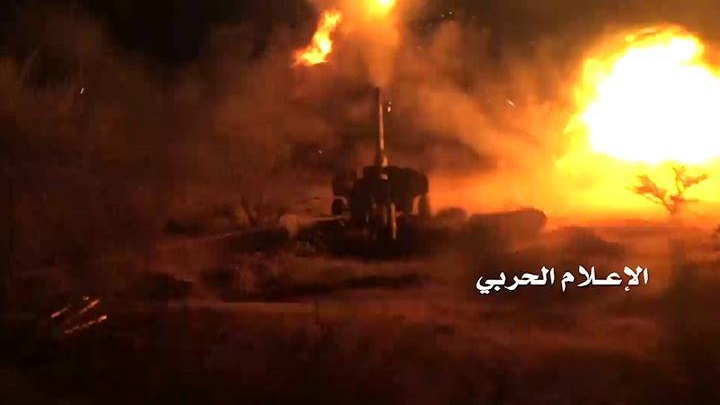
Here is how Yemeni joint forces escalate their acts against Saudi-led coalition
YemenExtra
Y.A
The Yemeni joint forces keep responding to the Saudi-led coalition’s airstrikes that killed and wounded over 600,000 people all over Yemen with firing missiles, foiling advances, attacking their sites and so on on Wednesday .
They launched airstrikes on Abha airport with Qasif-1 drone in Asir front, according to a military official.
They also hit Aramco company with Qasif-1 dron, fired a number of missiles, Bader-1, toward King Abdullah Economic City, fired Katyusha missiles toward Saudi soldiers’ gatherings in Mashriq site, and shot dead a Saudi soldier in Khubah in Jizan front.
Notably, they targeted Aramco Company’s distribution facility with several Badr-1 missiles and Saudi soldiers’ gatherings and their paid fighters in Sudais site with a missile, Zilzal-2 .Additionally, they carried out a sucessful offensive operation on the paid fighters’ sites , killing and wounding dozens of them and destroyed 4 Saudi military vehicles with missile and artillery shells in Sudais site in Najran front.
Furthermore, they targeted the Saudi Defense Ministry with Burkan-H2 missiles in the Saudi capital, Riyadh.
Al-Baida front witnesses that they killed and wounded scores of the paid fighters during foiling their advance toward Yemen joint forces’ sites in Qaifa district .
According to a statement by the Yemeni war media ,they carried out an attack on the paid fighters’ sites in Haijah area of Maslub district, killing and wounding many of them in AL-Jawf front.
They destroyed a military vehicle, loaded with paid fighters, with a guided missile in Melh valley of Nehm front, it read.
To conclude it with their artillery force that shelled gatherings of Sudanese army and coalition paid fighters in the north of Midi desert.
In March 2015, Saudi Arabia and a coalition of its regional allies — mainly the united Arab Emirates and Jordan — started a war against Yemen with the declared aim of crushing the Houthi Ansarullah movement, who had taken over from the staunch Riyadh ally and fugitive former president Abd Rabbuh Mansur Hadi, while also seeking to secure the Saudi border with its southern neighbor. Three years and over 600,000 dead and injured Yemeni people later, the war has yielded little to that effect.
It killed 14,291 civilians. Among the 14,291 killed victims are 2,086 women and 9,148 men, according to statistics approved by the Legal Center for Rights and Development.
The number of wounded has reached 22,537, of which are 2,284 women and 17,384 men, who have to accept their new reality of no longer being capable of living a normal life
Moving on to recheck on the damages inflicted by the Yemeni infrastructure, reports indicate that the Saudi regime targeted, with American intelligence support, 15 airports, 14 ports, 2,425 roads and bridges, 179 stations and power generators, 688 water tanks and networks, 410 stations & communication networks, 1,761 government institutions and 41, 3297 destroyed and damaged houses.
According to the latest statistics published by the Legal Center for Rights and Development, nearly 269 chicken and cattle farms have been bombed. In addition and amid an unprecedented famine witnessed in Yemen, the Saudi-led coalition struck 307 factories, 609 commercial markets, 6,912 business establishments, 722 food stores, 596 food tankers, 349 fuel stations, 262 fuel tankers and 3,757 transporters
Almost everything is a target in Yemen, including service facilities, whereas the most recent statistics report the bombing of 903 mosques, 309 hospitals and health centers, 869 institutions and schools, 141 university facilities, 264 tourism facilities, 112 sports facilities, 35 media establishments, 216 archeological sites and finally, while imposing a fatal siege on Yemen, 2,654 agricultural fields targeted.
“Hodeida should be supporting more than 20 million Yemenis. It should be the source of at least 70 percent of all imports to Yemen,” Suze van Meegen, a protection and advocacy adviser with the Norwegian Refugee Council, told AFP.
Earlier this month, the US Congress voted against a resolution that sought to end America’s support for the war.
Last week, the administration of US President Donald Trump approved weapons sales to Saudi Arabia totaling more than $1 billion, despite growing pressure from rights groups to halt arms deals between the West and Riyadh.
Amnesty International has slammed the United States, Britain and France for their continued arms sales to Saudi Arabia and the United Arab Emirates.
The UK-based rights group said the arms sales have been an “enormous harm to Yemeni civilians” over the course of the war.
As if it weren’t bad enough that Hodeidah and its environs are among the most severely harmed by the blockade and the threat of famine, the civilians living there are also at risk of being bombed for no reason. There is no excuse for bombing this house and killing these civilians. This attack is a gross violation of international law and a war crime, and the governments responsible for it should be held accountable. This is what the coalition does with the refueling and weapons that the U.S. provides them. Refueling coalition planes just makes it easier for them to carry out more outrageous attacks like this one. Secretary Mattis tried arguing the other day that refueling gives coalition pilots more time to make better decisions about where to drop their bombs, but that ignores the reality that coalition governments have routinely shown blatant disregard for civilian life throughout the war. This latest attack is just the latest example out of the thousands and thousands of strikes on civilian targets that the coalition has carried out.
At the same time Mattis made his statement, a $1 billion weapons deal to Saudi Arabia was announced on the same day. Along with the $100 billion weapons deal signed between Washington and Riyadh last year, this will obviously further empower Saudi’s military campaign on Yemen, which Mattis supposedly wants to end.
